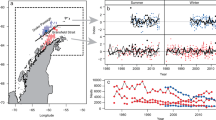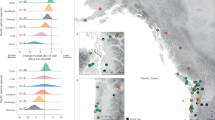Abstract
To understand the processes that regulate the abundance and persistence of wild populations is a fundamental goal of ecology and a prerequisite for the management of living resources. Variable abundance data, however, make the demonstration of regulation processes challenging1,2,3. A previously overlooked aspect in understanding how populations are regulated4,5,6 is the possibility that the pattern of variability—its strength as a function of population size—may be more than ‘noise’, thus revealing much about the characteristics of population regulation. Here we show that patterns in survival variability do provide evidence of regulation through density. Using a large, global compilation of marine, anadromous and freshwater fisheries data, we examine the relationship between the variability of survival and population abundance. The interannual variability in progeny survival increases at low adult abundance in an inversely density-dependent fashion. This pattern is consistent with models in which density dependence enters after the larval stage. The findings are compatible with very simple forms of density dependence: even a linear increase of juvenile mortality with adult density adequately explains the results. The model predictions explain why populations with strong regulation may experience large increases in variability at low densities7. Furthermore, the inverse relationship between survival variability and the strength of density dependence has important consequences for fisheries management and recovery, and population persistence or extinction8,9,10.
This is a preview of subscription content, access via your institution
Access options
Subscribe to this journal
Receive 51 print issues and online access
$199.00 per year
only $3.90 per issue
Buy this article
- Purchase on Springer Link
- Instant access to full article PDF
Prices may be subject to local taxes which are calculated during checkout



Similar content being viewed by others
References
Murdoch, W. W. Population regulation in theory and practice. Ecology 75, 271–287 (1994)
den Boer, P. J. & Reddingius, J. Regulation and Stabilization Paradigms in Population Ecology (Chapman & Hall, London, 1996)
Shenk, T. M., White, G. C. & Burnham, K. P. Sampling-variance effects on detecting density dependence from temporal trends in natural populations. Ecol. Monogr. 68, 445–463 (1998)
Murray, B. G. Can the population regulation controversy be buried and forgotten? Oikos 84, 148–152 (1999)
Turchin, P. Population regulation: a synthetic view. Oikos 84, 153–159 (1999)
Berryman, A. A., Lima Arce, M. & Hawkins, B. A. Population regulation, emergent properties, and a requiem for density dependence. Oikos 99, 600–606 (2002)
Hsiesh, C.-h. et al. Fishing elevates the variability in the abundance of exploited species. Nature 443, 859–862 (2006)
Sæther, B.-E., Engen, S., Islam, A., McCleery, R. & Perrins, C. Environmental stochasticity and extinction risk in a population of a small songbird, the great tit. Am. Nat. 151, 441–450 (1998)
Lande, R., Engen, S. & Sæther, B.-E. Stochastic Population Dynamics in Ecology and Conservation (Oxford Univ. Press, Oxford, 2003)
Drake, J. M. Density-dependent demographic variation determines extinction rate of experimental populations. PLoS Biol. 3, 1300–1304 (2005)
Wolda, H. & Dennis, B. Density dependence tests, are they? Oecologia 95, 581–591 (1993)
Godfray, H. C. L. & Hassell, M. P. Long time series reveal density dependence. Nature 359, 673–674 (1992)
Myers, R. A. Stock and recruitment: generalizations about maximum reproductive rate, density dependence, and variability using meta-analytic approaches. ICES J. Mar. Sci. 58, 937–951 (2001)
Sale, P. F. & Tolimieri, N. Density dependence at some time and place? Oecologia 124, 166–171 (2000)
Myers, R. A. & Cadigan, N. G. Density-dependent juvenile mortality in marine demersal fish. Can. J. Fish. Aquat. Sci. 50, 1576–1590 (1993)
Deriso, R. B. Harvesting strategies and parameter estimation for an age-structured model. Can. J. Fish. Aquat. Sci. 37, 268–282 (1980)
Schnute, J. A general theory for analysis of catch and effort data. Can. J. Fish. Aquat. Sci. 42, 414–429 (1985)
Harvey, A. C. Estimating regression models with multiplicative heteroscedasticity. Econometrica 44, 461–465 (1976)
Mertz, G. & Myers, R. A. Estimating the predictability of recruitment. Fish. Bull. 93, 657–665 (1995)
Myers, R. A. & Cadigan, N. G. Is juvenile natural mortality in marine demersal fish variable? Can. J. Fish. Aquat. Sci. 50, 1591–1598 (1993)
Mertz, G. & Myers, R. A. Match/mismatch predictions of spawning duration versus recruitment variability. Fish. Oceanogr. 3, 236–245 (1994)
May, R. M. C. Stability and Complexity in Model Ecosystems Ch. 2 (Princeton Univ. Press, Princeton, 1973)
Myers, R. A., Barrowman, N. J., Hutchings, J. A. & Rosenberg, A. A. Population dynamics of exploited fish stocks at low population levels. Science 269, 1106–1108 (1995)
Walters, C. & Kitchell, J. F. Cultivation/depensation effects on juvenile survival and recruitment: implications for the theory of fishing. Can. J. Fish. Aquat. Sci. 58, 39–50 (2001)
Leigh, E. G. The average lifetime of a population in a varying environment. J. Theor. Biol. 90, 213–239 (1981)
Rosenberg, A. A. et al. The history of ocean resources: modeling cod biomass using historical records. Front. Ecol. Environ. 3, 78–84 (2005)
Hutchings, J. A. & Myers, R. A. The effect of age on the seasonality of maturation and spawning of Atlantic cod, Gadus morhua. Can. J. Fish. Aquat. Sci. 50, 2468–2474 (1993)
Peterman, R. M. Form of random variation in salmon smolt-to-adult relations and its influence on production estimates. Can. J. Fish. Aquat. Sci. 38, 1113–1119 (1981)
Myers, R. A., Bridson, J. & Barrowman, N. J. Summary of worldwide stock and recruitment data. Can. Tech. Rep. Fish. Aquat. Sci. 2024, 1–327 (1995)
Hassell, M. P., Latto, J. & May, R. M. Seeing the wood for the tree: detecting density dependence from existing life-table studies. J. Anim. Ecol. 58, 883–892 (1989)
Mertz, G. & Myers, R. A. Influence of fecundity on recruitment variability of marine fish. Can. J. Fish. Aquat. Sci. 53, 1618–1625 (1996)
Manly, B. F. Stage-structured Populations: Sampling, Analysis and Simulation (Chapman and Hall, London, 1990)
Stuart, A. & Ord, J. K. Kendall’s Advanced Theory of Statistics Vol. 1 Distribution Theory (Oxford Univ. Press, New York, 1987)
Acknowledgements
We thank D. Tittensor for comments on the variance derivations and A. Edwards, B. Worm, D. Ricard and C. Barber for comments on the manuscript. This work was funded partly by the Irish government and partly by the European Union, under the National Development Plan 2000–2006, through “Supporting Measures in the Fisheries Sector” (to C.M.).
Author Contributions The original idea for this study was conceived by R.A.M. R.A.M., C.M. and W.B. developed the theoretical models for the variance in survival. C.M. conducted the empirical analyses. All authors contributed to the writing of the manuscript.
Author information
Authors and Affiliations
Corresponding author
Additional information
All data used are available at the stock-recruitment database http://www.mathstat.dal.ca/~myers/welcome.html.
Supplementary information
Supplementary Information
The file contains Supplementary Methods, Supplementary Figures 1-8 with Legends and Supplementary Table 1. The Supplementary Methods include analytical models for survival variability; delta approximations to survival variability; sensitivity analysis and meta-analytical methods. (PDF 927 kb)
Rights and permissions
About this article
Cite this article
Minto, C., Myers, R. & Blanchard, W. Survival variability and population density in fish populations. Nature 452, 344–347 (2008). https://doi.org/10.1038/nature06605
Received:
Accepted:
Issue Date:
DOI: https://doi.org/10.1038/nature06605
This article is cited by
-
Model averaging estimation for nonparametric varying-coefficient models with multiplicative heteroscedasticity
Statistical Papers (2023)
-
An urban stream can support a healthy population of coastal cutthroat trout
Urban Ecosystems (2017)
-
Marine fisheries as ecological experiments
Theoretical Ecology (2012)
-
Density dependence and the economic efficacy of marine reserves
Theoretical Ecology (2009)
-
Analyses support theory of stochastic regulation of fisheries
Nature (2008)
Comments
By submitting a comment you agree to abide by our Terms and Community Guidelines. If you find something abusive or that does not comply with our terms or guidelines please flag it as inappropriate.



